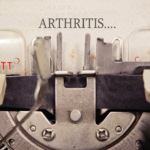The situation with PsA differs from that of RA because the presence of skin disease should alert providers (including dermatologists) to the possibility of PsA when patients report arthralgias and other symptoms. Correspondingly, providers can educate patients with psoriasis about the possibility of developing arthritis so that they can seek medical attention sooner. Given the age of patients with PsA and likelihood of coexistent osteoarthritis in this patient demographic, developing and implementing strategies for early diagnosis of PsA may be challenging, but can be part of an overall program of rheumatologists to educate providers on the full range of rheumatic diseases.
7. PsA vs. OA
Abstract 1792: Ganatra et al.7
I have often said that differentiating PSA from osteoarthritis (OA) in a patient with psoriasis and joint pain is one the biggest diagnostic challenges in rheumatology because of the paucity of biomarkers. Given the overlaps in the demographics of patients with PsA and OA, making this distinction is not uncommon in the clinic.
To fill in the gap in biomarkers, Ganatra and colleagues analyzed microRNAs (mRNAs) in the synovial fluid of knees from 12 patients with PsA and 12 with OA; additional samples from 35 PsA and 37 OA patients were used for validation. miRNA are small non-coding RNA molecules that serve as regulatory elements to modulate gene function in immune and other cells; thus, miRNA expression can be used as a marker for inflammation.
As shown by miRNA sequencing in this study, 51 miRNAs showed differences in expression comparing PsA and OA samples. While PsA and OA samples both showed increases in mitogen activated protein kinase (MAPK) and WNT pathways, two miRNAs (miR027b-30 and miR-223-3p) showed significant dysregulation in PsA compared to OA. The results were confirmed in a validation cohort.
Although these are interesting findings, early stage biomarker studies are often exploratory in nature, more likely generating data for understanding mechanisms than developing actionable laboratory tests. For a laboratory test, the information gained by miRNA testing needs to be beyond that of joint fluid cell counts, for example. For miRNA, data are needed on the patients with psoriasis and OA but not PsA to determine whether any of the changes observed with miRNA in the joint fluid reflect generalized immune system findings that could occur with just psoriasis alone.
8. Upadacitinib vs. Adalimumab
Abstract 2251: Taylor et al.8
Pain is dominant symptom of PsA and can be heterogeneous in origin, reflecting inflammation, damage and central sensitization (nociplastic pain). Although many different therapies have now been approved for the treatment of PsA, both biologic and non-synthetic DMARDs, the mode of the action of these agents is not fully understood. Important questions concern whether modulation of pain is a direct analgesic action or is an indirect action resulting from a reduction in inflammation.


